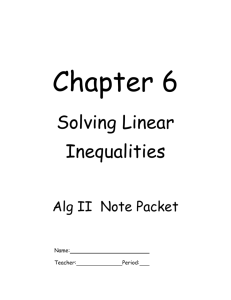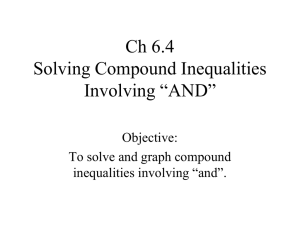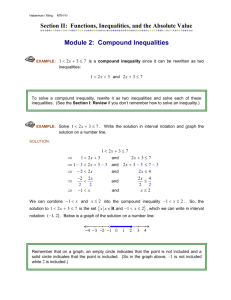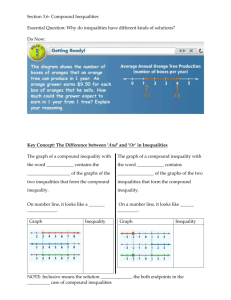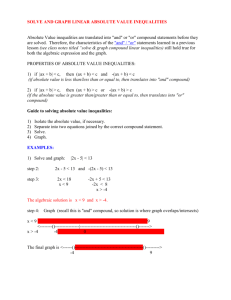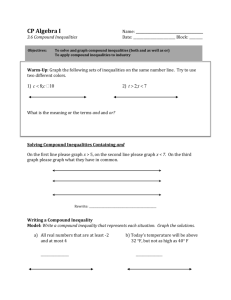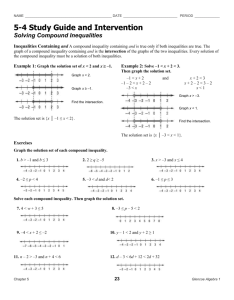Compound Statements (Equations and Inequalities)
advertisement
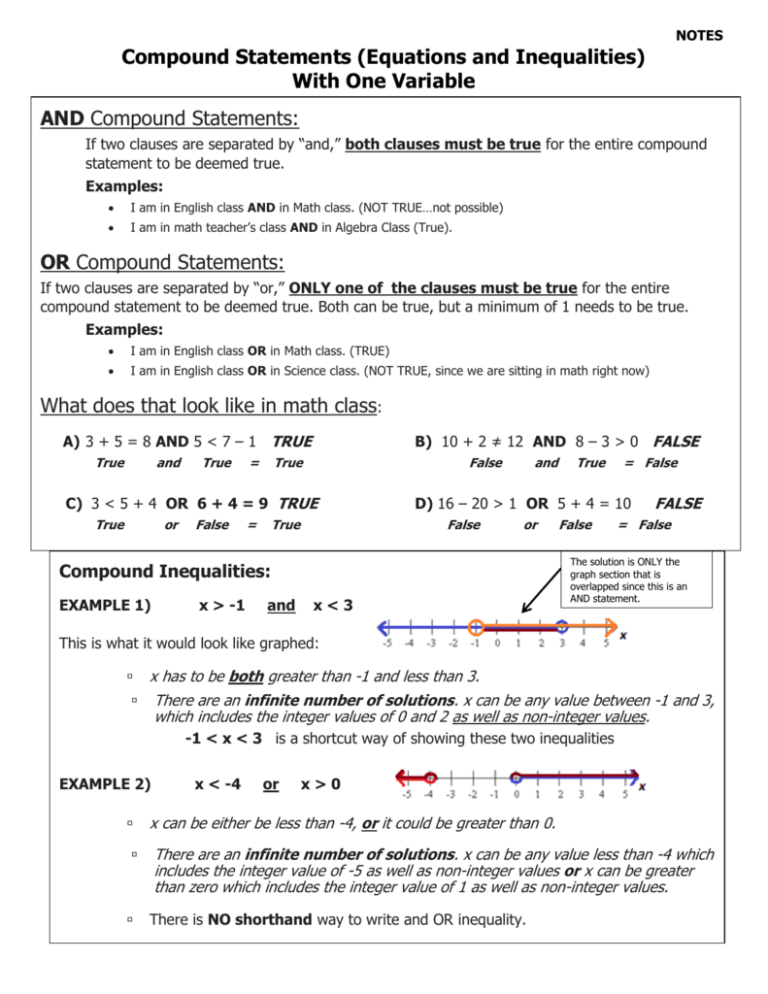
NOTES Compound Statements (Equations and Inequalities) With One Variable AND Compound Statements: If two clauses are separated by “and,” both clauses must be true for the entire compound statement to be deemed true. Examples: I am in English class AND in Math class. (NOT TRUE…not possible) I am in math teacher’s class AND in Algebra Class (True). OR Compound Statements: If two clauses are separated by “or,” ONLY one of the clauses must be true for the entire compound statement to be deemed true. Both can be true, but a minimum of 1 needs to be true. Examples: I am in English class OR in Math class. (TRUE) I am in English class OR in Science class. (NOT TRUE, since we are sitting in math right now) What does that look like in math class: A) 3 + 5 = 8 AND 5 < 7 – 1 TRUE True and True = B) 10 + 2 ≠ 12 AND 8 – 3 > 0 FALSE True False C) 3 < 5 + 4 OR 6 + 4 = 9 TRUE True or False = True and x > -1 and = False D) 16 – 20 > 1 OR 5 + 4 = 10 False or Compound Inequalities: EXAMPLE 1) True x<3 False FALSE = False The solution is ONLY the graph section that is overlapped since this is an AND statement. This is what it would look like graphed: x has to be both greater than -1 and less than 3. There are an infinite number of solutions. x can be any value between -1 and 3, which includes the integer values of 0 and 2 as well as non-integer values. -1 < x < 3 is a shortcut way of showing these two inequalities EXAMPLE 2) x < -4 or x>0 x can be either be less than -4, or it could be greater than 0. There are an infinite number of solutions. x can be any value less than -4 which includes the integer value of -5 as well as non-integer values or x can be greater than zero which includes the integer value of 1 as well as non-integer values. There is NO shorthand way to write and OR inequality. Special cases with Solving and Graphing Inequalities: Example Solution # 1: Using one of the inequalities to describe both. x > -5 OR x > -2 Can be simplified to only… x > -5 See what happens when you graph both x > -5 & x > -2 on the same number line: Example Solution # 2: Using the entire Real Number System x > -5 OR x < -2 Can be simplified to the set of all Real Numbers “ℝ”.. See what happens when you graph both x > -5 & x < -2 on the same number line: Example Solution #3: Using the Empty Set. The solution of two inequalities joined by “and” may end up looking like it has solutions but beware of the “and” because there may be no solution at all. x> 3 AND x < -2 Can be simplified to the empty set “ 𝝓 “ See what happens when you graph both x > 3 & x < -2 on the same number line: Remember, with an AND statement the solution is where the graphs OVERLAP. There is no overlap, so there is no solution. How do you solve a compound inequality or compound equation with One Variable? You can break it back apart into two separate inequalities and solve for each of them. Example: 1) Consider the compound inequality -5 < x < 4 Rewrite the inequality as a compound statement of inequality. x > -5 and x < 4 In words: x can be any number between -5 and 4 The graph of the solution set: Example: 2) Consider the compound inequality -5 < 2x + 1 < 4 Rewrite the inequality as a compound statement of inequality and solve each for x: 2x + 1 > -5 -1 -1 2x > -6 2 2 and x < -3 < x < 2x + 1 < 4 -1 -1 2x < 3 2 2 3 2 Rewrite the solution to the compound inequality as one inequality: x > -3 and 3 2 In words: x can be any number between -3 and 3 2 The graph of the solution set: Example: 3) The same problem as Example #2 can be solved without rewriting it. Here’s how: -5 < 2x + 1 < 4 -1 -1 -1 -6 < 2x < 3 2 2 2 -3 < x < 3 2

